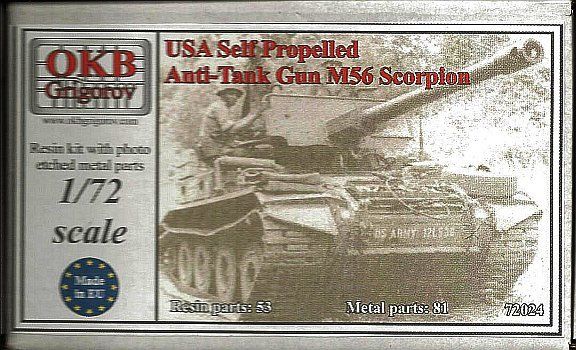|
Before beginning this preview, I should state that for many years, I contemplated scratchbuilding an M56, and I have
gathered a fair amount of photographic references. Hence my comments below represent the opinion of someone who has spent many hours looking at the
details of this vehicle. Note that this kit apparently comes in two versions (with the same kit number). The obvious difference is the listed number
of Metal (photoetched) parts. My kit contains 53 resin and 81 metal parts. The alternate version (I believe an earlier issue) contains 53 resin and
786(!) metal parts. Looking at the photos of the kit on the OKB web site, the earlier issue included one-piece black tracks, with additional PE parts
added to depict the metal sections of each track link. My kit has each track moulded as 2 hard resin sections, each with excellent moulded-in details,
and no PE parts for the tracks. Interestingly, neither set of tracks is actually shown in the instructions.
The M56 SPAT (Self-propelled Anti-tank) or Scorpion was designed as a light weight anti-tank weapon that could be air dropped. The vehicle was completely
unarmoured. The only protection provided to the crew was a thin gun shield, to protect from back blast. The M56 was armed with the M54 90 mm gun, a version
of the same gun as fitted to the M46 Patton tank. The continuous rubber band tracks ran on pneumatic tires. The combination of light weight and wide tracks
made for an exceptionally low ground pressure (4.2 psi). M56s saw their only combat during the early stages of the Vietnam war, when they equipped the
173rd Airborne Brigade.
OKB Grigorov's M56 comes packed in a small but sturdy box, with a black and white picture of an M56 in Vietnam on the front. While the box states the kit
contains 53 resin parts, mine contained 61, including the 4 pieces of resin track not shown in the instructions. Inside the box was a one piece hull,
wrapped in bubble wrap, a resealable plastic bag containing the detail parts, a second resealable bag containing the 4 sections of track, and a third
containing the photoetched parts. As we have come to expect from OKB Grigorov, the resin moulding is top class. There are a couple uneven spots on the
sides of the hull, but they will be covered by the photoetched fenders. Unlike some of the other OKB kits I have purchased, I could find no evidence of
artifacts of the 3D printing process used to create the masters. The front and rear sections of the gun barrel suffered from heavy mould seams, and the
rear section was warped. Fortunately, the M56's untapered barrel can be easily replaced with plastic tube.

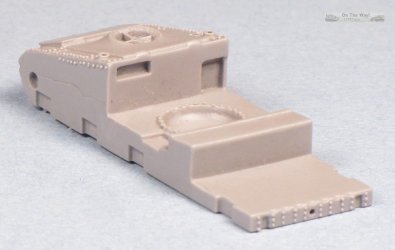
The one piece hull casting

The gun parts

The suspension arms
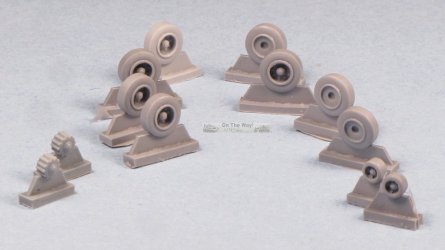
The wheels
The kit includes two frets of photoetched parts. The larger fret (approximately 0.09 mm thick) includes the fenders, numerous covers for the ammunition
stowage tubes, and a pair of beautifully etched engine grills, amongst other parts. The smaller fret (approximately 0.18 mm thick) includes the gun shield,
steering wheel, barrel travel lock, and several details for the gun.
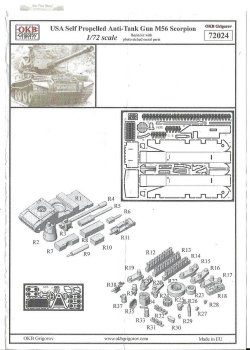
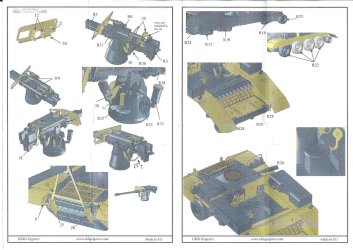
The instructions are the biggest weakness of the kit. A single double-sided A4 sheet is provided, with shaded CAD renderings. The combination of black text
on top of dark grey shading used for the resin parts is difficult to read. Complex assemblies such as the gun and mount are shown in several views, each
with different components installed, but no overall exploded view, and only one small image of the complete assembly. I could not locate PE parts 10 and
15 on the instructions, and other items such as the headlight brush guards are shown on the instructions without part numbers, and apparently not provided
in the kit. PE parts that require complex folds, such as the gunner's seat mount, part 11; the gun shield braces, part 12; the breech lever, part 18; and
the driver's seat back mount, part 23; are only shown in the folded shape, with no fold lines etched on the parts or details of how to fold them to shape.
No painting instructions or decals are included.

The resin tracks are provided as 4 sections, each of 60 cross bars (the M56 had continuous band tracks without individual links. On the real vehicle, each
track consisted of 8 sections, and each section had 11 cross bars each for a total of 88 cross bars per side. The kit should provide plenty of spares. Often,
spare 11 cross bar sections of track were stowed on the sloped sections of the rear fenders.
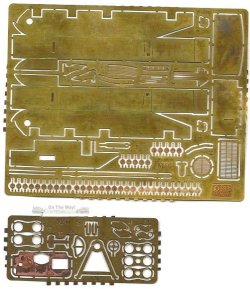
The photoetched frame
As mentioned, the fenders are provided as PE parts. The front and rear curved mudguards lack any ribs in the kit. Real M56s had at least three styles of front
and rear mudguards - with 3 reinforcing ribs, with 4 ribs, and unreinforced with the corners cut back (as shown on the box top photo). The kit parts can easily
be modified to the cut back style, which appears most common in Vietnam-era photos.
The open fighting compartment is missing some prominent items. An AN-PRC-8, 9, or 10 radio set was mounted at the left rear of the compartment, with the antenna
mounted on top of the left stowage bin (part R8). The vehicle commander's seat was mounted on top of the radio. The loader's seat was mounted on the right stowage
box, near the gun shield. The kit provides 3 seats, but only shows the installation of the driver's and gunner's seats. You can install the 3rd seat for either
the loader or vehicle commander, but you'll still need one more seat for a complete crew. Also, the kit is missing the prominent fire extinguisher, mounted at
the right rear of the fighting compartment.
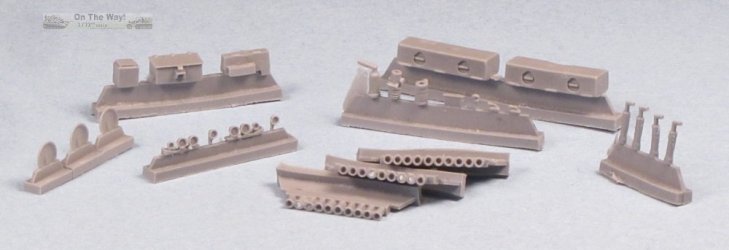
The hull detail parts
PE part 9 is a folding platform that is normally deployed to allow the crew more room to operate the gun. The instructions only show the platform in the stowed
position. All external stowage is missing from the kit. This should include a tow cable on the rear fenders, a pioneer tool kit mounted on the underside of the
folding rear fighting compartment extension (part 9), and a jerry can stowed on the front right fender. Unofficial stowage often included spare track sections
and road wheels.
The kit provides 4 resin mufflers (though only 2 are required). The kit is missing the vertical exhaust pipes extensions that exit the outboard ends of the
mufflers (visible on the box top photo). The only thing 'wrong' I notice with the kit is that all 3 rows of stowed ammunition show the rounds neatly aligned
in a straight line. The topmost row of 10 rounds should actually follow the curvature of the edge plate that sits on top of the ammo (PE part 4).
Photoetched parts are sometimes used for parts that are not 2-dimensional, for example the travel lock for the gun, which in reality should have a tubular
cross section. The clear driver's windscreen is not provided, nor is the windscreen wiper. Some details that could have easily been depicted in photoetch
are not included, such as the brush guards for the headlight clusters (though these are shown in the instructions), the rear fender braces to which the
mudguards attach, and the mud scraper flap under the rear fenders.
I apologize if these comments seem overly harsh or petty. The kit overall is of a very high quality and I congratulate Grigori on the fine job he has done
on producing a kit of this little known vehicle. Overall, I'm very happy with the kit, and look forward to building it. Should OKB Grigorov want to improve
the kit to address any of the issues I've mentioned above, I'd be happy to provide detailed reference photos.
Preview sample purchased by the author.
OKB Grigorov products are available at

|
